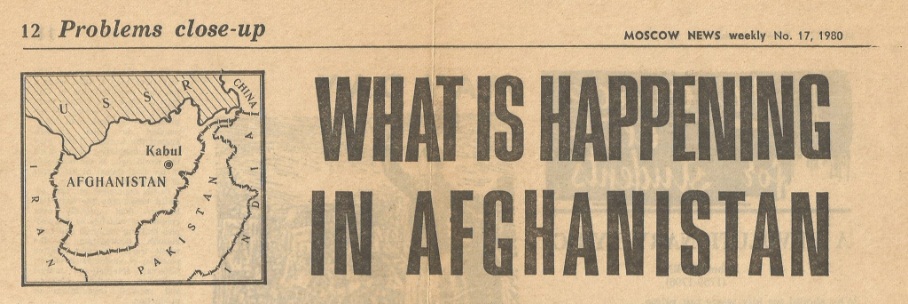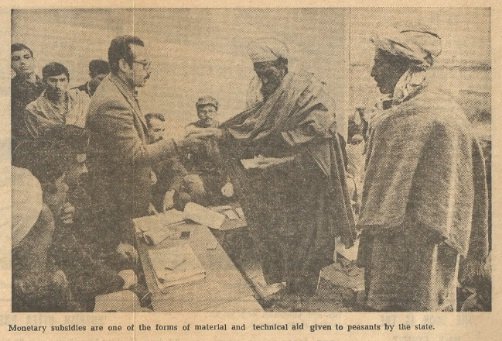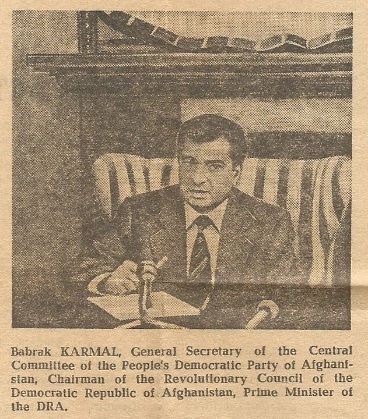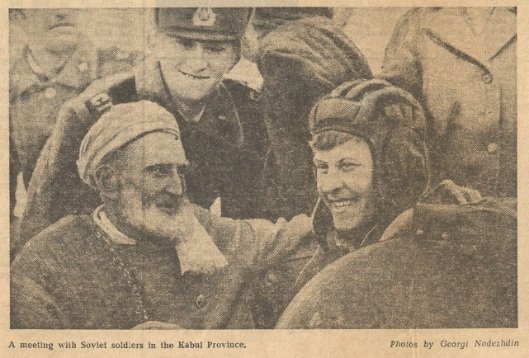Afghanistan: learning the Past to understand the Present
Twitter is like a jungle and most of its trees are rotten, but from time to time, among all those trees broken down and blackened you can find a green tree, a tree that helps you understand the world in a way that puts yet another dent in the official Western narrative parroted in the MSM and Hollywood. You can find truly amazing threads like the one posted by @mixedforestzone. He went to great lengths to scan a newspaper article from Moscow News from November 17, 1980 entitled “What is happening in Afghanistan” written by Igor Timofeyev. I transcribed this article below, but feel free to go to the thread, read it there if you prefer and don’t forget to like and retweet. Needless to say, I thank @mixedforestzone for posting this. Please enjoy.
What is happening in Afghanistan by Igor Timofeyev

The desires for imperialist expansion in Afghanistan are rooted deeply in history. The British colonialists made their first attempts on Afghanistan’s independence in the first half of the 19th century, when a British-Indian expeditionary corps was dispatched, westwards, over the mountain passes in 1838, under the pretext of protecting their colonies in India, but in reality, with the intention of using Afghanistan as a bridgehead for penetrating Central Asia. They expected to quickly crush the resistance of the Afghan army and Nomad tribes. Events, however, took a turn which was not provided for in the plans. The proud and freedom-loving Afghans meted out a crushing rebuff to the aggressor. At first, the invaders penetrated, comparatively easily, deep into Afghanistan and even captured Kabul, but in 1842 they suffered a number of defeats and had to get out of the country.
The British colonialists made their second attempt to occupy Afghanistan in 1878-1881. Like the first attempt, it ended in failure, even though Afghanistan, bled white by the exhausting wars, was forced to accept some of the interventionists’ conditions.
Confronting the British lion
What they couldn’t take at gunpoint, the British Interventionists bargained for at the negotiation table. In the early 1880s, the British, capitalizing on Emir Aburrahman’s internal weakness, imposed a number of enslaving commitments upon Afghanistan. De jure Afghanistan was deprived of the right to conduct its external relations in any way than through the viceroy of India and the British colonial authorities. De facto this signified a clear limitation of the country’s sovereignty.
At the outset of the 20th century, Afghanistan became, essentially, a semicolony. Its dependence on Britain increased, especially during the reign of Emir Habibullah who accepted all the commitments imposed upon the country and, getting annual subsidies from the colonialists, encouraged their penetration into the Afghanistan economy.
The lickspittle course adopted by Habibullah generated sharp dissent amidst the opposition. The patriotic intelligentsia and liberal-minded landowners united in the “young Afghans” movement and demanded the restoration of Afghanistan’s independence, limitation of the ruling Emir’s power, adoption of a constitution and the institution of reforms to enliven the country’s economy. Amanullah, one of Habibullah’s sons, shared these ideas. In February 1919 he replaced his father on the throne.
Emir Amanullah rode on horseback to inspect the troops of the Kabul garrison. He unsheathed his sword and pledged never to sheathe it again until he had achieved complete independence for Afghanistan.
Amanullah was as good as his word. In his enthronement speech in February 1919 he declared Afghanistan an independent state and sent Chelmsford, the viceroy of India, a message in which he said that in the future he did not intend to honour the enslaving commitments which were contrary to his country’s national interests.
The young Soviet Republic was the first state in the world to officially declare its recognition of Afghanistan’s independence, and it rendered null and void all the tsarist agreements and treaties which infringed upon Afghan sovereignty.
Emir Amanullah sent a letter to Lenin on April 7, 1919
“Since you, your Majesty, my great and kindly friend -the president of the Great Russian state,” he wrote, “undertook, together with your comrades, upon yourself the honourable and noble task of expressing concern for the peace and the well-being of all people and proclaimed the principle of freedom and equality of countries and nations the world over, I am happy to send you, for the first time, on behalf of the Afghan people who are striving for progress, this friendly message of mine from independent and free Afghanistan.”
Two weeks later Emir Amanullah sent Lenin a second message in which he offered to establish allied and friendly relations between the two countries.
In the meanwhile, the British colonialists unleashed the third British-Afghan war. It was short but very bloody and ended in the complete rout of the aggressors who, by that time, were very much weakened by the defeats imposed upon them by the Red Army on the Soviet trans-Caspian front.
On August 8, 1919, at the talks in Rawalpindi, Britain was forced to recognize Afghanistan’s independence.
But it did so only on paper. In real life the British had no intention of stopping their attempts to retain influence in Afghanistan.
Stinting no money they bribed the tribal chiefs, supplied them with arms and ammunition and courted the extreme right wing of the Moslem clergy who were dissatisfied with Amanullah’s policy.
The British put all their stakes on Habibullah Ghazi, a slight, black-bearded Tajik, wearing a long cape and thonged sandals on his bare feet. This ringleader of the rebels, known as Bacha Saqao, was, according to the British plans, to capture Kabul and proclaim himself the Emir.
The treacherous plan was fulfilled. The several months which the illiterate bandit spent in power were marked by massive persecution of the patriots. The surviving Basmachi gangs in northern Afghanistan reared their heads and some 2,000 bandits started making regular raids on the territory of Soviet Central Asia. The Bacha Saqao regime, which brought the country’s economy to the verge of catastrophe, collapsed under the blows of national patriotic forces led by Mohammed Nadir Khan, the new king of Afghanistan.
The real and the sham friend
The Soviet-Afghan Treaty of Friendship was signed in Moscow on February 28, 1921. It was one of the first documents in mankind’s history which provided for relations, between a great power and a small state, based on equality and non-interference into internal affairs and on friendship and respect. This Treaty, which the Afghan side ratified on August 14, 1921, laid the foundation for the good-neighbourly relations between the two countries, which has become a firm tradition and will continue for many decades to come.
The effective cooperation between our country and its southern neighbour has invariably evoked a malicious reaction on the part of the imperialists who tried to force Afghanistan to reject it’s political neutrality and to draw it into a system of aggressive military blocs in the hope of turning the country into a bridgehead for aggression against the USSR. The USA, which replaced Britain in the colonialists’ arrangements in Asia after World War II, acted especially diligently.
The USA concentrated on gaining dominance over industry and the foreign trade of the economically backward Afghanistan. A single example of the so-called US “aid” to Afghanistan will be enough to expose the goals pursued by neo-colonialists in that country. In the late 1940s the USA coerced the Afghan government into an agreement with the Morrison-Knudsen Company to build the irrigation network and highways in the south of the country. The US firm, having undertaken to build several projects simultaneously, failed to put them into operation on schedule. All Afghanistan’s hard currency accumulations in the American banks were spent in the first two years to cover the expenditures. The Afghan government had to negotiate a loan from the USA to the tune of 21,000,000 dollars. Still, the construction work dragged on for several more years and had practically absorbed all the country’s hard currency accumulations. According to an Afghan journalist, this kind of “aid” more resembled plunder in broad daylight.
To bring political pressure to bear upon Afghanistan, the USA used the traditional dependence of Afghan foreign trade on transit through Pakistan.
This pressure upon Afghanistan reached its peak in 1955 when CENTO bloc was being set up. The USA and Britain deliberately aggravated the Afghan-Pakistani territorial controversy, bringing them practically to armed confrontation. Pakistan, whom the Americans were setting on Afghanistan, deprived its neighbour of the right of transit though Pakistani territory.
The USSR came to Afghanistan’s assistance. The Soviet-Afghan agreement on transit matters was signed in June 1955. According to this agreement,Afghanistan was granted the right of tax-free transit of its export goods through Soviet Territory. The economic blockade of Afghanistan was frustrated.
Nevertheless, the danger of armed intervention remained. The USA was arming Pakistan with the aim of intimidating the Afghans and forcing them to reject their independent foreign policy course. Faced by a military threat, Afghanistan approached the Soviet Government in the mid-1950s with a request for assistance in strengthening its defence capacity.
Soviet-Afghan relations continued to expand.Ever since 1954 the USSR has supplied the bulk of Afghanistan’s foreign imports, and since 1956 has been the recipient of most of its exports. Machinery and equipment were the main items imported by Afghanistan from the USSR.
Special mention should be made of the fact that the USSR has never delivered commodities to Afghanistan which would compete with its developing industry and has imported from Afghanistan mainly those staples which our southern neighbour is most desirous of selling - above all its wool and cotton.
The Revolution is a ring of fire
Afghanistan, which was rated among the most underdeveloped countries in the world, made a leap from the Middle Ages to the 20th century in the spring of 1978. The April revolution opened the road for the Afghan people to liberation from feudal oppression and imperialist dependence. It opened broad vistas of democratic development, freedom and progress. The overcoming of the ages-old backwardness and feudal prejudices usually takes a long time, but the very first decrees issued by the people’s power laid the foundation for radical socio-economic transformations in the country.
All the things which seemed impossible only yesterday - abolition of debt to landowners and money lenders, emancipation of women, the new law on marriage and, lastly, the famous No. 8 decree on the agrarian reform - started to gain ground, drawing into conscious activity the millions of downtrodden people who had no rights at all, but have now gained human dignity and their basic rights.
The People’s Democratic Party of Afghanistan, which was formed in the complex conditions of the revolutionary struggle in the 1960-1970s, led the transformation of the Afghan society which was proceeding on an unprecedented scale. The leaders of the PDPA, after overthrowing the pro-imperialist Daoud regime comparatively quickly, realized that the main difficulties lay ahead.
In order to grasp the special drama of the breaking down of old concepts and the consolidation of new principals and relations, it is necessary to take into account the specifics of the social, ethnic and religious pattern of the Afghan society.
Afghanistan’s strategically advantageous situation in the centre of Asia at the junction of ancient caravan routes, has attracted the attention of invaders from times immemorial. There was probably not a single large-scale invasion movement in medieval Asia that bypassed Afghanistan. The migration routes of ethnically different tribes had criss-crossed on its territory in the most peculiar combinations. By the time the independent Afghan state emerged in 1747, the country was a conglomerate of different ethnic groups, languages, dialects, races and nomadic, seminomadic, settled and semisettled tribes.
This ethnic and linguistic motley is preserved to our day. If we add to this that the social life of the majority of these groups combines elements of settled and nomadic life, then it is easy to imagine how complex is the task of regulating the inter-national relations.
From the point of view of religion the population in Afghanistan is relatively homogeneous. Of all the Afghans, 95 per cent are Moslem of the Sunni sect of the Hanifi denomination and the five per cent that are left include Shi’ites called Imamis, Isma’ilites, Buddhists, and an infinitesimal number of Jews and Christians.
The vast majority of Afghans are illiterate. The emirs, feudal nobility and landowners, who kept millions of people in chains of semislaved dependence, capitalized on these from times immemorial.

There is hardly any need to say how difficult it is for anything new and progressive to make headway in such conditions, especially if we take into account that the dominating classes - the landowners and the reactionary part of the clergy who were deprived of all their ages-long privileges - are fiercely resisting and trying to turn back the march of time.
Terror tactics, sabotage, intimidation and subversion are the traditional forms of activities of any counterrevolutionary movement. And in the conditions of Afghanistan they are supplemented also by the possibilities of inciting tribal mutinies.
Ever since the outset of the revolution the former masters of Afghanistan have been fleeing eastwards towards the territory of Pakistan, where the Pashtun tribes, severed from their native land by the British in the last century, lived behind the “Durand line”. They flee for social reasons but the leitmotif of the counterrevolutionary propaganda is, of course, the “struggle for the faith”.
Initially, the ringleaders of the insurgents acted without coordination sending small gangs over the border to raid villages, tu murder PDPA members, rural teachers and activists of the cooperative movement, and to cruelly persecute all those who sympathize with the new power by threatening to kill all their families and deport abroad all the men who are capable and handling weapons.
One doesn’t have to be a seer to realize that each action of the rebels is organized and guided by their American patrons. The imperialist circles, in fact, launched nd undeclared war against the new regime from the very first days of the Afghan revolution, using the internal counterrevolution as their trump card.
Louis Dupreé, a CIA agent and an expert of Afghanistan, surfaced in Kabul right after the April revolution. He was assigned to establish contacts with Afghan counterrevolutionaries. Louis Dupreé’s mission fell through. In November 1978 he was turned out of the country and went to Pakistan where he headed the operational group which became, essentially, the coordinating HQ of the armed gangs of counterrevolutionaries.
It became absolutely clear by beginning of 1979 that the USA and its satellites were banking of an armed intervention in Afghanistan. US, Israeli, Egyptian and Chinese instructors appeared in the area of the Afghan-Pakistani border where the counterrevolutionary gangs were concentrated, and arms and ammunition flowed there in quantity.
The escalation of the aggression against Afghanistan started in the spring of 1979 as soon as the snow thawed on the mountain roads. The bands of counterrevolutionaries crossed the border and carries out acts of sabotage in nearly half the country’s 28 provinces. Of the targets was Herat, the third biggest city in Afghanistan, where the rebels captured several military installations and food depots and massacred the civilian population.
The military foundations of the Afghan reaction had complete and ever-growing financial and military aid of the USA, Pakistan, China and Saudi Arabia. The instructors who came from these countries organized the training of the hired assassins.
Therefore, what is happening is not an inter-Afghan conflict, as the Western mass media try to describe it, but a broad-scale external aggression against the sovereign state of Afghanistan.
A conspiracy of pharisees
The members of the counterrevolutionary formations considerably increased in the autumn of 1979 when Hafizullah Amin was in power. Today, when the months of Amin’s terror which took the lives of thousands of honest PDPA members is a thing of the past, many people are asking the question: how could this have happened?
History tells us that revolutions produce not only the wave but the foam as well. The revolution in Afghanistan was no exception. Together with the honest and loyal fighters, the PDPA ranks were infiltrated by all sorts of political soldiers of fortune for whom the strengthening of their personal power was more important than the common cause.
Hafizullah Amin was one such adventurer. He had already established close relations with the CIA in the early 1960s when he was a student at Columbia University in the USA. When he came back to Afghanistan in 1965, he joined the PDPA which had been founded by Nur Mohammad Taraki. The PDPA, unfortunately, failed to preserve the unity of its ranks in the complicated conditions of revolutionary struggle and in 1967 it split into the Khalq and Parcham wings, each of which started operating independently. They reunited only in the summer of 1977 just a few months before the April revolution.
After April 1978 the Party’s unity weakened, which was, probably, only natural in the complex, post-revolutionary conditions when life posed new problems every day and opinions could differ almost every one of them. This was to Amin’s liking. He decided to capitalize on the inter-Party differences in order to rid himself of all competitors and make it to the very top of the Party and state hierarchy. Amin launched a campaign against the old Party cadres who had formerly belonged to the “Parcham” faction. Over 2,000 Party members were subjected to persecution on Amin’s trumped-up charges. Some 500 of them were shot.
This was not enough for Amin. Early in the spring of 1979 he cmmitted the most heinous of all his crimes - he arrested and then murder Nur Mohammad Taraki, founder of the PDPA, leader of the Afghan revolution.
Having taken over, already from September 1979 he started to prepare the grounds for making closer contact with the USA. He held secret meetings with US officials and sent his emissaries to the USA. At the same time, he established contacts with the rebels in Pakistan. Amin was preparing a coup d’etat, aimed at the destruction of the revolution’s gains, dissolution of the PDPA, liquidation of Party cadres and the establishment of his own dictatorship of the country.
The truly revolutionary forces, who rallied around a group of time-tested PDPA veterans led by Babrak Karmal, managed to find out Amin’s plans in time and late in december 1979 to render the criminal harmless. The revolution, whose destiny had been jeopardized, was saved. But the ominous shadow of external aggression still loomed large over Afghanistan.

In this complex situation, Babrak Karmal’s government sent a request to the Soviet leadership to render military assistance, in accordance with the December 1978 Treaty of Friendship, Good-Neighbourliness and Cooperation that was signed by the two countries. The request of the lawful government of Afghanistan corresponded completely to the latter and spirit of the UN Charter, particularly its Article 51 that provides for the inalienable right of states to collective and individual defence to ward off aggression.
A limited contingent of Soviet troops arrived in Afghanistan late in December 1979. The events, therefore, took a turn that had not been envisaged in Washington.

The thwarting of the counterrevolutionary coup infuriated those who thought that they already had Afghanistan where they wanted it.
Carter’s administration used the events in Afghanistan as a pretext for making a sharp turn towards the cold war, for fresh aggravation of the international situation. The USA fabricated the lie on the “Soviet threat” to Iran and Persian Gulf countries, and started openly to enormously increase its military presence in that area. The acme of the anti-Soviet hysteria was reached when the US Administration came up with the absurd decision to boycott the Summer Olympic Games in Moscow. Washington is now going out of its way to impose this decision upon its allies and satellites.
The USA has simultaneously sharply increased its efforts to organize a new crusade against Afghanistan.
The latest sortie of the Afghan reaction, prepared by the special services of the USA, Pakistan and China, erupted in Kabul on February 21-22. Armed thugs provoked riots, scattered leaflets inciting rebellion and plundered shops for two days. They went in for pillage and killed civilians. The DRA security forces quelled the rioting bandits very quickly. As has already happened in the past, the traces again led to Washington and Islamabad.
The rabid hatred for the new revolutionary Afghanistan has brought together very different partners in one camp. The reactionary Arab regimes led by Egypt, and the Peking hegemonists are especially ardent in this anti-Afghan and anti-Soviet chorus.
By issuing appeals for “Moslem solidarity” President Sadat is trying to divert attention from his own deep isolation in the Arab and Moslem world, caused by his collaborationist, treacherous course. By betraying the Arab people of Palestine and by “ceding” the occupied Jerusalem to the zionists, Sadat is now crying about the need to “protect” Moslems in Afghanistan. This is truly boundless hypocrisy!
Washington’s puppets in the Middle East act mainly from a desire to do as their transatlantic sovereign bids. As for China, its active participation in the Anti-Afghan bloc (or the “consortium” as the Western press calls it delicately) is determined by a number of far-reaching strategic goals. Peking dreams of turning Afghanistan into a bridgehead for aggression against the USSR, India and other countries in the region. And its participation in the “consortium” secures China deliveries of the Western arms it needs so much to fulfil its hegemonistic plans in the South-East Asia.
The “consortium” of anti-Afghan forces that are creating this most dangerous situation in Asia is a conspiracy of pharisees who, under the cover of the invented need “to protect Moslems” from a non-existing threat, are pursuing, what are, essentially, neo-colonialist goals, without the elast concern for the Moslems, their destiny or their rights.
It can hardly be hoped that the enemies of the Afghan people will drop their aggressive plans. The reactionary forces suffer defeats, but are far from losing hope of turning the march of time backwards. And those in Afghanistan who, arms in hand, are prepared to defend the noble principles of their April revolution from the impingements of both internal and external enemies, are fully aware of all this.
Here ends the article.
The reason why I wanted to share this is because this article surely, back when this was published, was dismissed as communist propaganda. Today, many of the things quoted here have been proven true. Particularly the funding of extremist groups by the US and the Kingdom of Saudi Arabia and the legality of the Soviet intervention. The only thing that the article missed is when the author said that " The events, therefore, took a turn that had not been envisaged in Washington". This we know today that it was not so, but instead it was what Washington was looking for all along.
Today we have been able to confirm many of the allegations previously dismissed as Soviet propaganda. Perhaps we should go back and think about the Cold War with new eyes. We might have missed something important.
Thank you for reading. If you enjoyed it, please share it with everyone in all social media platforms. Don’t forget to upvote and resteem. If you would like to read more posts check out my feed. You can also follow me on Twitter: @realGonzaLopez